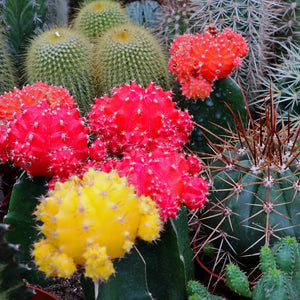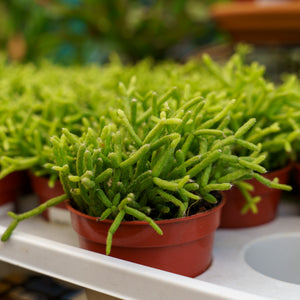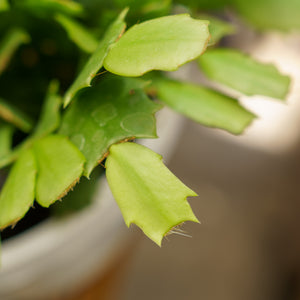The Cactus Guide
Cacti are among the easiest and most rewarding houseplants to grow, offering a wide range of shapes, sizes, and textures. Known for their unique appearance, low maintenance, and resilience, houseplant cacti are ideal for beginners and seasoned plant collectors alike. Whether you're growing a traditional desert cactus or a forest-dwelling epiphytic variety, these fascinating plants add architectural interest and personality to any indoor space. Here's everything you need to know about growing and caring for houseplant cacti.

About
Houseplant cacti come from two main groups: desert cacti and epiphytic (or tropical) cacti. Desert cacti, like Opuntia gomei 'Old Mexico' and Consolea rubescens, are characterized by spines and thick, fleshy stems adapted to arid environments. Tropical cacti, such as Epiphyllum oxypetalum, Rhipsalis baccifera, and Schlumbergera x buckleyi (Christmas Cactus), typically lack spines and have flatter stems that are adapted to humid, shaded environments.
Popular indoor cacti include:
- Epiphyllum 'Shark Tooth' – with jagged, zig-zag stems and occasional blooms.
- Epiphyllum anguliger (Fishbone Cactus) – known for its striking, angled foliage.
- Rhipsalis capilliformis – with delicate, cascading stems ideal for hanging pots.
- Schlumbergera x buckleyi – commonly called the Christmas Cactus, prized for its vivid winter blooms.
- Opuntia humifusa – a smaller prickly pear species that can adapt to indoor environments.
With the right light, soil, and watering schedule, cacti thrive indoors and bring a unique sculptural aesthetic to home decor.
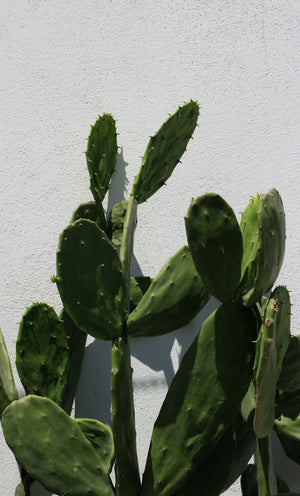
PLANTING
- USDA Hardiness Zones (Indoors): All houseplant cacti thrive year-round indoors with proper care.
- Soil: Use a fast-draining cactus or succulent potting mix. For tropical cacti, add extra peat or coco coir to retain light moisture.
- Containers: Choose pots with drainage holes to prevent root rot. Unglazed clay pots are ideal for desert cacti to allow moisture to evaporate quickly.
- Light Requirements: Desert Cacti: Bright, direct light (south- or west-facing windows). Tropical Cacti: Bright, indirect light or dappled sun.
- Planting Time: Can be planted or repotted anytime indoors, though spring and early summer are ideal for stimulating growth.
To plant or repot, gently remove the cactus from its container, loosen the roots, and place it in fresh, well-draining mix. For spiny varieties, use gloves or tongs to handle the plant safely.

CARE
- Watering: Desert Cacti: Water sparingly. Let soil dry out completely between waterings. In winter, reduce watering to once a month or less. Tropical Cacti: Water when the top inch of soil feels dry. These cacti enjoy slightly more moisture, especially during blooming seasons.
- Humidity: Desert cacti prefer dry conditions. Tropical cacti tolerate and benefit from moderate humidity.
- Fertilizing: Apply a diluted cactus fertilizer monthly during the growing season (spring to early fall).
- Pruning: Remove dead or damaged stems with clean shears. Prune leggy stems to encourage fuller growth.
- Pests & Diseases: Watch for mealybugs, scale, and root rot. Avoid overwatering and treat pests promptly with insecticidal soap or neem oil.
- Repotting: Repot every 2-3 years or when roots outgrow the container. Use fresh cactus mix to replenish nutrients and improve drainage.
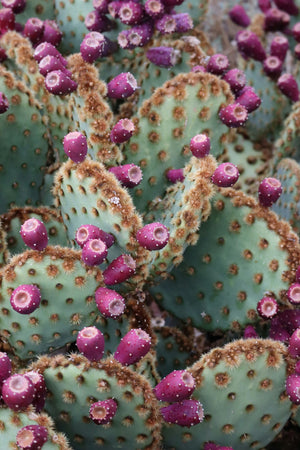
HOW TO USE
Cacti are highly versatile and lend themselves to a variety of interior design styles:
- Accent Plants: Their sculptural forms make a bold statement on windowsills, side tables, and shelves.
- Hanging Displays: Use cascading varieties like Rhipsalis baccifera or Epiphyllum guatemalense var. Montrose in hanging pots.
- Group Plantings: Combine multiple small cacti with varying textures and shapes in shallow trays for a modern desert arrangement.
- Blooming Decor: Seasonal bloomers like the Schlumbergera x buckleyi add color during winter months.
- Office Plants: Low-light tropical cacti are ideal for adding greenery to workspaces with filtered light.
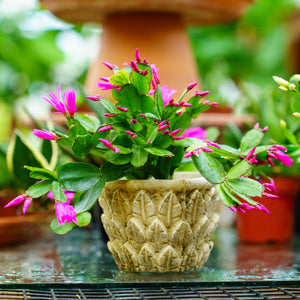
Common Questions
- Are cactus good houseplants? Yes, cacti are low-maintenance, long-living, and adapt well to indoor environments with the right care.
- How to take care of a cactus houseplant? Provide bright light, use fast-draining soil, water sparingly, and avoid high humidity for desert types.
- How often do you water a cactus houseplant? Water every 2-4 weeks, depending on species and season. Always let the soil dry out between waterings.
- How to care for a Christmas cactus houseplant? Provide bright, indirect light, keep soil lightly moist during the growing season, and encourage blooms by exposing it to cooler temps and shorter days in fall.
- Are cactus poisonous to cats? Most true cacti are non-toxic to cats, but spines can cause injury if chewed or touched.
- Are cactus poisonous to dogs? Cacti are generally non-toxic to dogs, but sharp spines can harm curious pets. Place out of reach if necessary.
Conclusion
Cacti are excellent houseplants for anyone looking to add structure, texture, and resilience to their indoor plant collection. With species like Epiphyllum anguliger, Consolea rubescens, and Schlumbergera x buckleyi, there's a cactus to suit every space and style. Easy to care for and rewarding to grow, these remarkable plants are perfect for both sunny windows and shaded corners, bringing nature’s artistry into your home year-round.
The Cactus Collection
Sold Out

